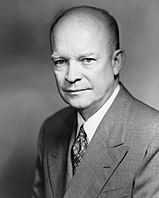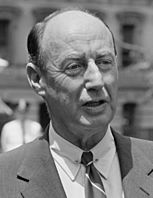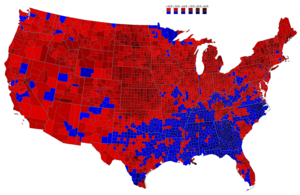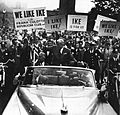United States presidential election, 1952 facts for kids
|
|||||||||||||||||||||||||||||
|
|||||||||||||||||||||||||||||
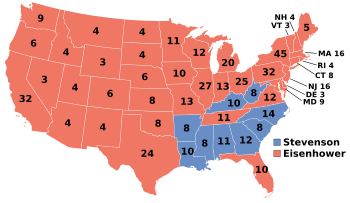
Presidential election results map. Red denotes those won by Eisenhower/Nixon, Blue denotes states won by Stevenson/Sparkman. Numbers indicate the number of electoral votes allotted to each state.
|
|||||||||||||||||||||||||||||
|
|||||||||||||||||||||||||||||
The United States presidential election of 1952 was a big event. It was held on November 4, 1952. The main candidates were Adlai Stevenson, who was the Governor of Illinois, and General Dwight D. Eisenhower. Eisenhower won the election with a large number of votes. He received 442 electoral votes, while Stevenson got 89.
The president at the time, Harry S. Truman, could have run again. A new rule, the 22nd Amendment, limited presidents to two terms. However, this rule did not apply to Truman. Even so, Truman decided not to run for president again. The Democratic Party then chose Adlai Stevenson as their candidate.
Eisenhower was 62 years old when he won. He was one of the older candidates to be elected president. This record stood until Ronald Reagan was elected in 1980 at age 69.
Contents
Who Ran for President?
Many people wanted to become president in 1952. The two main political parties, the Democrats and the Republicans, each chose one person to represent them.
Democratic Candidates
The Democratic Party had several people hoping to become their candidate. Here are some of the most well-known:
- Adlai Stevenson II, who was the Governor of Illinois
- Estes Kefauver, a U.S. Senator from Tennessee
- Richard Russell, Jr., a U.S. Senator from Georgia
- W. Averell Harriman, a former Secretary of Commerce from New York
- Alben W. Barkley, who was the Vice President at the time, from Kentucky
- Robert S. Kerr, a U.S. Senator from Oklahoma
- Harry S. Truman, the current President from Missouri
Democratic Candidates Gallery
-
Senator Richard Russell, Jr. of Georgia
-
Former Secretary of Commerce W. Averell Harriman of New York
Vice President Barkley was 74 years old. Some labor union leaders did not support him because of his age. President Truman had thought about choosing Senator Estes Kefauver as his running mate. However, Truman decided not to run for president at all. Truman's approval ratings were low at the end of his time in office.
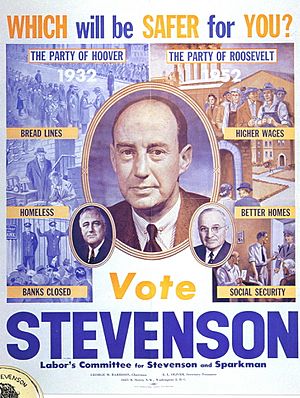
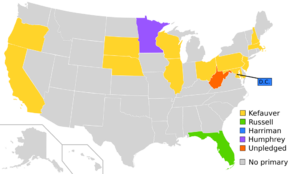
Republican Candidates
The Republican Party also had several strong candidates. Here are the main ones:
- Dwight D. Eisenhower, a famous general and former Supreme Allied NATO Commander from New York
- Robert Taft, a U.S. Senator from Ohio
- Harold Stassen, a former Governor of Minnesota
- Earl Warren, the Governor of California
Republican Candidates Gallery
-
General Dwight D. Eisenhower former Supreme Allied NATO Commander of New York
-
Former Governor Harold Stassen of Minnesota
Election Results by State
The election results showed that Eisenhower won by a large margin. He won the popular vote and most of the electoral votes. The table below shows the final numbers for the main candidates.
| Candidate (Party) | Electoral votes |
States carried* |
Popular vote |
Pct. | |
|---|---|---|---|---|---|
| Eisenhower (Republican) | 442 | 39 | 34,075,529 | 55.2% | |
| Stevenson (Democratic) | 89 | 9 | 27,375,090 | 44.3% | |
| Hallinan (Progressive) | 0 | 0 | 140,746 | 0.2% | |
| Hamblen (Prohibition) | 0 | 0 | 73,412 | 0.1% | |
| Hass (Socialist Labor) | 0 | 0 | 30,406 | 0.1% | |
| Hoopes (Socialist) | 0 | 0 | 20,203 | 0.0% | |
| MacArthur (Constitution) | 0 | 0 | 17,205 | 0.0% | |
| Others | 0 | 0 | 19,351 | 0.0% | |
| Total | 531 | 48 | 61,751,942 | 100% | |
States with Close Results
Some states had very close election results. The difference between the winning candidate and the losing candidate was less than ten percent. The colors show which party won the state. Red means Republican, and blue means Democrat.
- Kentucky: The winner won by only 0.07%.
- Tennessee: The winner won by 0.27%.
- South Carolina: The winner won by 1.44%.
- Missouri: The winner won by 1.56%.
- Rhode Island: The winner won by 1.84%.
- West Virginia: The winner won by 3.85%.
- Delaware: The winner won by 3.88%.
Images for kids
See also
 In Spanish: Elecciones presidenciales de Estados Unidos de 1952 para niños
In Spanish: Elecciones presidenciales de Estados Unidos de 1952 para niños


